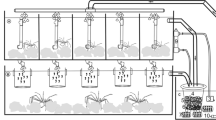Abstract
Species diversification is today considered as a major issue for the sustainable development of the Mediterranean aquaculture. For successful propagation of any species however, larval rearing is considered a bottleneck and therefore the development of appropriate tools is essential. Mesocosm is a semi-intensive technology that facilitates larval rearing of several species integrating principles of both intensive and extensive aquaculture, which solves biological problems and many of their technical, human and economical consequences. The extensive (and now even the semi-extensive) strategy is used in the most critical segments of the rearing process during the early developmental stages, when larvae are still extremely weak, sensitive to intensive environment, easily stressed and difficult to feed. The intensive strategy is used as soon as larvae are considered mature enough to be reared easily using classical methods. The technology was used for the rearing of two species, with potential for aquaculture, the sharpsnout seabream (Diplodus puntazzo) and the white seabream (Diplodus sargus sargus). Three groups of each species were monitored for a period of 50–70 days post hatching. Survival for both species was about 54% at the end of the trials. Sharpsnout seabream larvae reached 19.6 ± 0.9 mm total length and 107.2 ± 31.9 mg body weight 50 days post hatching. White seabream larvae 60 days post hatching reached 32.7 ± 2.7 mm total length and 450 ± 70 mg body weight. In order to verify the economical viability of the technology, the individual production cost for each species was estimated and reached ¢0.027 for white seabream and ¢0.043 for sharpsnout seabream. Results indicate the reliability of the technology for the larval rearing of the two species.
Similar content being viewed by others
References
Anonymous 1997. Interregional Action for Technology Transfer. Report of the Definition Phase to E.U. DG16, Brussels, 220 pp.
Anonymous 2002. Interregional Action for Technology Transfer. Final Report to E.U. DG16, Brussels, 238 p.
Bengoa Ruigomez M.V., Sanmartin M., Hatziathanasiou A., Divanach P. and Kentouri M. 1995. On the use of bloom strategy in large volume phytoplankton culture for initiation of rapid mass production of Brachionus plicatilis (Muller). In: Castello i Orvay F. and Calderer i Reig A. (eds.), Proceedings of the 5th National Congress on Aquaculture, Universitat de Barcelona Publication, pp. 109-113.
Ben Khemis I. 1997. Elevages larvaires des poissons méditerranéens: optimisation de la production en mésocosme et diversification des espèces. Thèse Européenne Université de droit, d'économie et des Sciences d'Aix-Marseille III, 186 p.
Bever J.E., Christensen E.B., Christensen V., Kiorboe T., Munk P., Paulsen H. and Richardson K. 1985. Summary of Danish enclosure experiments. Comm. Meet. Int. Counc. Explor. Sea C.M., ICES, Mini symposium, No. 7.
Dhert P., Divanach P., Kentouri M. and Sorgeloos P. 1998. Rearing techniques of difficult marine fish larvae. World Aquaculture 29(1): 48-55.
Divanach P. 1985. Contribution a la connaissance de la biologie et de l' élevage de 6 sparides Méditerranéens: Sparus aurata, Diplodus sargus, Diplodus vulgaris, Diplodus annularis, Lithognathus mormyrus, Puntazzo puntazzo (Poissons téléostéens). Thèse de doctorat dès Sciences, Université de Sciences et Techniques du Languedoc, Montpellier, 479 p.
Divanach P. and Kentouri M. 2000. Hatchery techniques for specific diversification in Mediterranean finfish larviculture. Proceeding of the CIHEAM-TECAM network held in Zaragoza, 24–28 May 1999. Cah. Options. Mediterr. 47: 75-87.
Grice G.D. and Reeves M.R. (eds.) 1982. Marine Mesocosms, Biological and Chemical Research in Experimental Ecosystems. Springer-Verlag, 492 pp.
Hatziathanassiou A., Divanach P., Kotzabassis K., Anastasiadis P. and Kentouri M. 2001. Performances of a solar tubular photobioreactor for hyperintensive mass culture of the microalgae Chlorella minutissima in Crete. Proceedings of the 10th Panhellenic Conference of Ichtyologists. Chania (Greece), 18–20 October 2001, pp. 137-140 (in Greek).
Kentouri M. 1985. Comportement larvaire de 4 Sparides méditerranéens en élevage: Sparus aurata, Diplodus sargus, Lithognathus mormyrus, Puntazzo puntazzo (Poissons téléostéens). Thèse de doctorat dès sciences, Université de Sciences et Techniques du Languedoc, Montpellier, 492 p.
Kentouri M. and Divanach P. 1983. Contribution à la connaissance du comportement et de la biologie des larves de marbré Lithognathus mormyrus (Sparidae) en élevage. Ann. Zootech. 32(2): 135-152.
Kentouri M., Divanach P., Thomson M., Papandroulakis N. and Cross T. 1994. A comparison of rotifer (Brachionus plicatilis) sampling methods in marine larval rearing tanks. Book of Abstracts Bordeaux Aquaculture '94', European Aquaculture Society, Special Publication No. 21, Oostende, pp. 110-111.
Koumoundouros G., Divanach P. and Kentouri M. 1999. Ontogeny and allometric plasticity of Dentex dentex (Osteichtyes: Sparidae) in rearing conditions. Marine Biology 135: 561-572.
Lalli C.M. 1990. Enclosed Experimental Marine Ecosystems: A Review and Recommendations. Coastal and Marine Studies. Springer-Verlag, 218 pp.
Nehr O. 1996. Développement d'une méthodologie de production semi intensive d'alevins en mer dans des enceintes à renouvellement semi continu: application à l'élevage du loup Dicentrarchus labrax. Thèse de Doctorat, Univ. de la Méditerranée Centre d'océanologie de Marseille, 209 p.
Papandroulakis N., Divanach P., Anastasiadis P. and Kentouri M., 2001. The pseudo-green water technique for intensive rearing of seabream (Sparus aurata) larvae. Aquaculture International 9: 205-216.
Pitta P. 1996. Dynamique du système planctonique en mésocosmes d'élevage de daurades. Thèse de Doctorat, Université de Crète, 209 p.
Sokal R.R. and Rohlf F.J. 1981. Biometry. 2nd edn. Freeman and Company, New York, 859 pp.
Author information
Authors and Affiliations
Rights and permissions
About this article
Cite this article
Papandroulakis, N., Kentouri, M., Maingot, E. et al. Mesocosm: A Reliable Technology for Larval Rearing of Diplodus puntazzo and Diplodus sargus sargus . Aquaculture International 12, 345–355 (2004). https://doi.org/10.1023/B:AQUI.0000042134.21211.ab
Issue Date:
DOI: https://doi.org/10.1023/B:AQUI.0000042134.21211.ab




